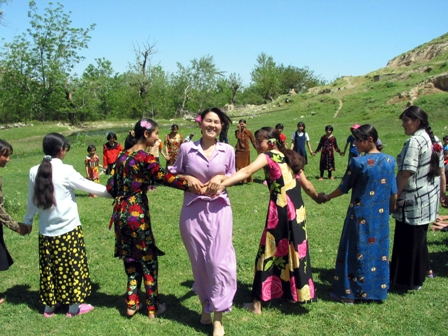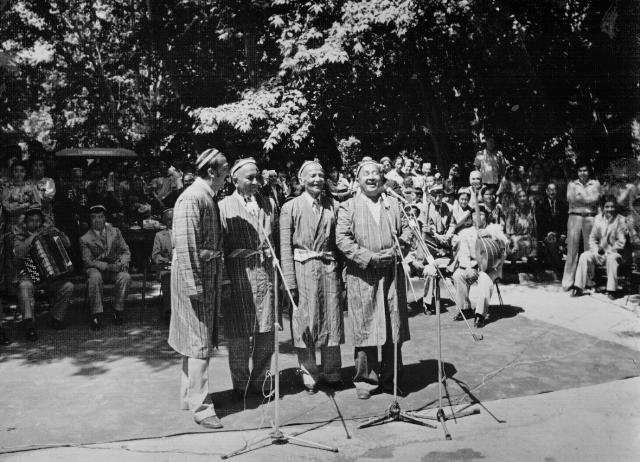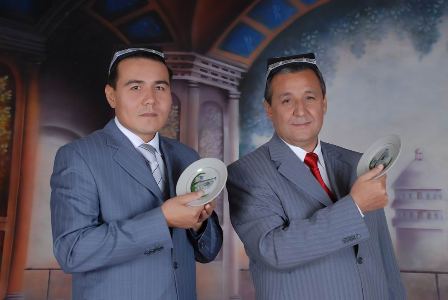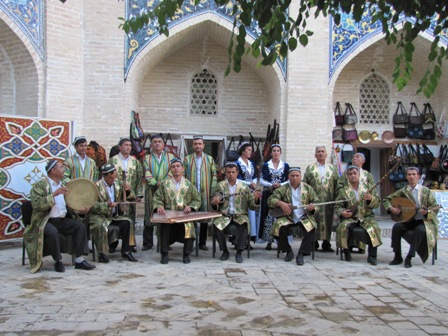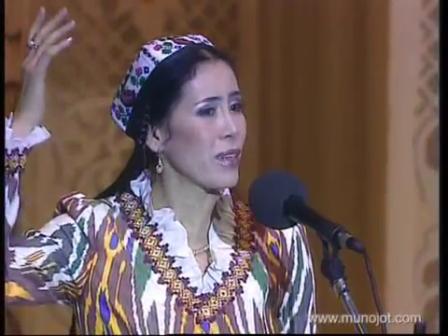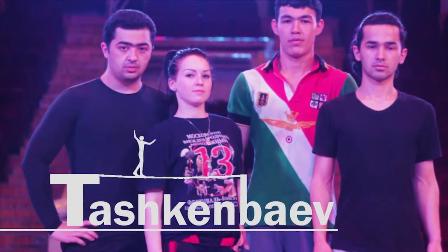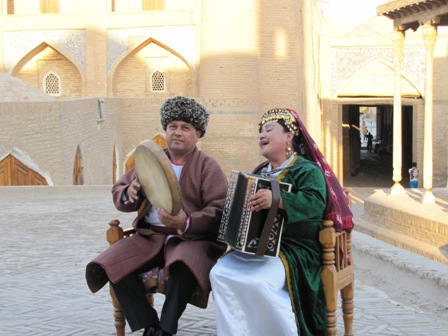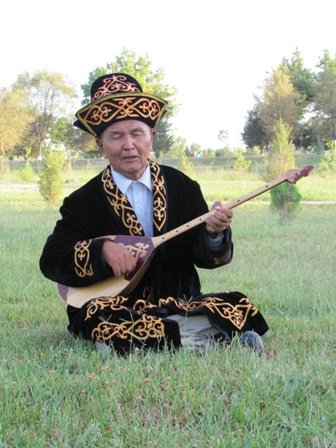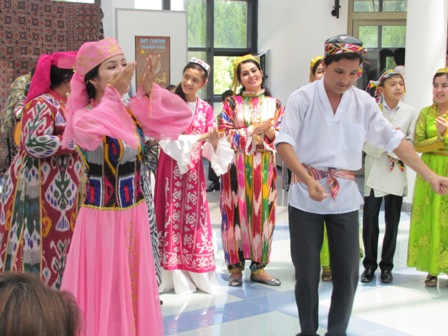Ferghana-Tashkent Maqoms
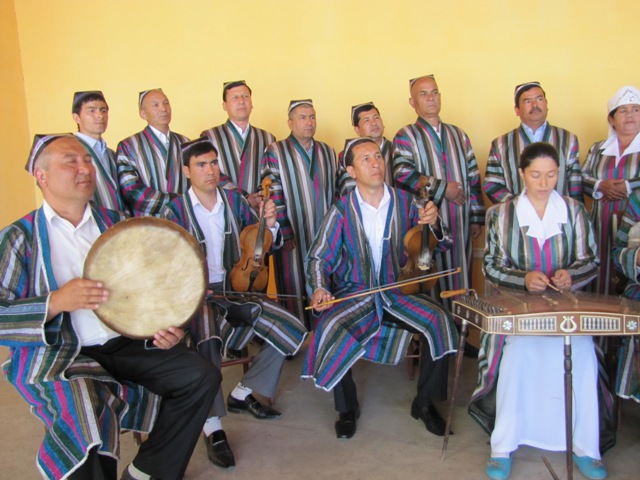
Domain: Performing Arts
Index Number: 02.01.03
Ferghana-Tashkent maqoms represent a phenomenon which is unique and original in the system of maqomat (maqom art) of Uzbekistan, existence of which is associated with musical culture of the cities of the Ferghana Valley and Tashkent region in the form of separate instrumental and vocal samples and small cycles (from two to seven parts).
Ferghana-Tashkent maqoms got formed at the turn of the ХVIII-ХIХ century on the basis of shuba of Shashmaqom and musical traditions of the Ferghana Valley. They represent independent instrumental and vocal-instrumental cycles, which have identical names of shuba. In comparison to the cycles of Shashmaqom and Khoresm maqoms, Ferghana-Tashkent maqoms are original large and small instrumental and vocal cycles, created on the basis of certain shuba of Shashmaqom (such as sarakhbor, tarona, savt, qashqarcha, soqiynoma and ufar). Instrumental maqom cycles include: 3-part ones as "Mushkiloti dugoh", "Khojiniyoz", "Ajam taronalari"; 5-part ones as "Chorgoh", "Nasrullo", "Munojot"; 7-part ones as "Miskin", which are performed solo (by playing on tanbur, dutar, nay, gidjak) or by instrumental ensemble. Vocal maqom cycles include: 3-part ones as "Nasrullo"; 5-part ones as "Chorgoh", "Bayot", "Bayot Sheroziy", "Shakhnoz-Gulyor"; 7-part ones as "Dugoh-Husayniy". Notably, parts of Ferghana-Tashkent maqoms are highlighted with the numbers (except maqom "Gulyor-Shakhnoz"). Singing style is solo, i.e. a singer is accompanied by instrumental ensemble. In some maqoms it is possible to see parts bearing some specific names, for instance in the maqom of "Shakhnoz-Gulyor" part 1 is called "Gulyor", 2 – "Shakhnoz", 3 – "Chapandozi Gulyor", 4 – "Ushshoq", 5 – "Gulyor ufari"; in maqom cycle "Miskin" part 3 is called "Adoiy" and 4 – "Asiriy"; in cycle "Nasrullo" part 2 is called "Chapandoz", 3 – "Qashqarcha", 4 – "Tarona", 5 – "Ufar".
Development of musical language of maqoms is closely connected with the impact made on them by peculiarities of traditional music of the Ferghana Valley, in particular, by ashula, katta ashula and instrumental melodies. All these can be observed not only in maqom cycle but also in individual distinct instrumental and vocal maqom compositions, bearing the names of their creators or names of a locality. For instance "Choli Iroq", "Toshkent Iroghi", "Qoqon Iroghi", "Yovvoyi Chorgoh", "Yovvoyi Ushshoq", "Yovvoyi Tanovar", "Segoh" or on the basis of shuba Ushshoq – "Khojand Ushshogi" or "Ushshoq Sodirkhon hofiz", "Samarqand Ushshogi" or "Ushshoq Khodja Abdulaziz", "Toshkent Ushshogi" or "Ushshoq Mulla Toychi", etc. In addition to them in the Ferghana Valley became widely spread instrumental maqom compositions and cycles for surnay (wind instrument) such as "Navo", "Surnay Dugohi", "Surnay Iroqi", "Yakkakhonlik", "Begi Sulton", etc. They were performed in urban environment, in the court of rulers and in many folk events such as weddings, folk promenades (sayils) and holidays, during tightrope walking (dorbozlik) shows. This is a bright testimony that they were widely popular and connected to the people, and that its musical language and dialect is closer to national traditions. The poetic texts, used in vocal cycles and composition were based on ghazals of orental poetry, i.e. Sakkokiy, Navoiy, Bobur, Uvaysiy, Nodira, Zebuniso, Amiriy, Muqimiy, Furqat, etc.). Maqoms of Bayot, Chorgoh, and Dugoh Khusayni emerged on the basis of shuba of Shashmaqom (maqoms of Navo and Dugoh) of similar name; Shakhnoz-Gulyor emerged on the basis of shuba of maqoms called Segoh and Rost. The composition and structure of this maqom (i.e. Shakhnoz-Gulyor) significantly differs from other cycles; its parts, in terms of content and style of singing, are more complex; it differs from others with richness of melos, expressiveness, emotionality and originality. Maqom cycle "Chorgoh" is adapted to traditions and style of singing of the Ferghana Valley. However, musical rules of shube of Shashmaqom, which are used in it, are simpler.
In the XX century Uzbek bastakors (composers) created certain versions of a number of maqom cycles. For instance: Chorgoh 6 and Dugoh-Khusayni 8 were created by Yunus Rajabiy; a five-part Nasrulloi (vocal and instrumental cycles), maqom Miskin (a seven-part vocal maqom cycle, created based on instrumental cycle of Miskin; based on the poem by Miskin) and vocal cycle Ushshoq (Qadimiy Ushshoq, Zikru Ushshoq, Umrzoq Polvon Ushshoq, Fattokhon Ushshoq) were created by famous singer and composer, Fattokhon Mamadaliev. Also, other versions of Ushshoq (such as Ushshoq Rasulqori, Ushshoq Orifkhon, etc.) became wide-spread.
Ferghana-Tashkent maqoms and maqom compositions were recorded by V. Uspenskiy, V. Belayev, Yunus Rajabiy and were published in the form of separate collections or became part of larger collections ("Uzbek Folk Songs", a 2-volume edition, Tashkent, 1939; "Uzbek Folk Music", a 4-volume edition, Tashkent, 1955-1958; "Shashmaqom", a 6 volume edition, Tashkent, 1966-1975; "Uzbek Maqoms. Shashmaqom", Tashkent, 2007). Maqom cycles and composition have been mostly mastered verbally and based on "ustoz-shogird" ("master-apprentice") methodology, while relevant information and knowledge has been integrated in the new system of music education (i.e. in colleges of music and art, Conservatoires, music schools).
Considerable contribution to the development and promotion of the Ferghana-Tashkent maqoms was made by famous musicians, singers and bastakors of Uzbekistan, including Khoja Abdulaziz Abdurasulov, Mulla Toychi Toshmuhammedov, Sodirkhon Babasharifov, Yunus Rajabiy, Abduqodir Ismoilov, Akhmadjon Umrzoqov, Jorakhon Sultonov, Mamurjon Uzoqov, Rasulqori Mamadaliev, Shojalil and Shorakhim Shoumarovs, Shoqosim, Shoolim and Shoakbar Shojalilovs, Orifkhon Khotamov, Imomjon Ikromov, Orif Alimakhsumov, Ortiqkhoja Imomkhojaev, Khalima Nosirova, Saodat Qobulova, Tavakkal Qodirov, Kamoliddin Rakhimov, Ochilkhon Otakhonov, Turghun Alimatov, Munojot Yochieva and others. It is thanks to these people that Ferghana-Tashkent maqoms were safeguarded, preserved and got enriched. And it is thanks to these people that young musicians and singers of new generation were brought up. Nowadays, Ferghana-Tashkent maqoms are included in the programmes of international and republican competitions among young performers of maqom and maqom ensembles.





